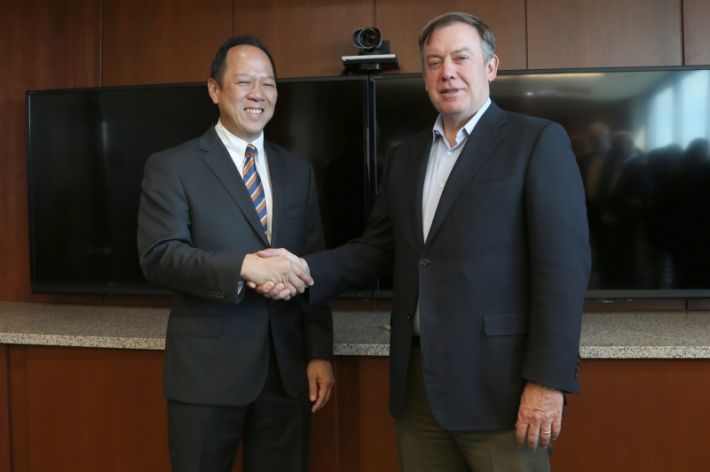Kamehameha Schools took another step forward this month by announcing a new agreement with Arizona State University to cooperate and advance education and sustainability.
This is the third such agreement – partnerships with the University of Hawaiʻi and Chaminade University were finalized earlier in the school year – that propels Goal 2 of Kamehameha’s SP2020, which describes an improved educational system with KS contributing to communities’ collective efforts for Native Hawaiian learners.
“This Memorandum of Understanding (MOU) signifies a call to action for both of our organizations. Partnerships such as this also demonstrate our commitment to foster local and global servant leadership and cultural engagement among Native Hawaiians and all learners in Hawaiʻi,” said KS CEO Jack Wong.
“We acknowledge that we cannot do this alone, but instead we need to work together with those who share the same goals and whose priorities align with ours, with Hawai‘i’s.”
“Arizona State University and Kamehameha Schools share a mission to improve the communities around us through education,” said ASU President Michael M. Crow. “This partnership creates pathways for our students to sustain and enrich society -- at a local level and far beyond.”
Areas of academic priority include education, sustainability, and STEM (science, technology, engineering and mathematics).
Under the MOU, both organizations agree to encourage and promote cooperation in key areas within a portfolio of initiatives. Such areas include research and innovation; long distance learning; philanthropic funding and advancement; and student enrollment, persistence and completion.
U.S. News and World Report ranked ASU No. 1 in the United States in innovation in 2016, ahead of Stanford and MIT. According to Diverse: Issues in Higher Education magazine, ASU ranked first in the nation for doctoral degrees and 10th in the nation for undergraduate degrees in education awarded to Native Americans last year.
“Their innovative online training platforms and technology are some of the best in the world in training teachers effectively, and enabling learners with interactive, exploratory learning,” said Kā‘eo Duarte, Kamehameha’s vice president of Community Engagement and Resources.
“The ultimate outcome both ASU and KS are striving for is well-being. We realize that our goal, to help elevate the well-being of Native Hawaiian students and all of Hawaiʻi’s learners and families, cannot be done alone. A lot of the issues we face in Hawaiʻi are shared by other communities and will not always be solved locally.
“Part of that is looking to strong national thought partners with the platform and tools already in place, that can support the advancement of our Lāhui in this generation,” Duarte added.
One focus of ASU’s Julie Anne Wrigley Global Institute for Sustainability is to prepare educators and leaders with a rich understanding of how diverse fields such as humanities, the sciences, design, and policy can be integrated to form a more sustainable society.
One early example of the three-year pilot program will allow KS and ASU to leverage the resources of both educational institutions – ʻāina and innovation – to train Hawai‘i’s teachers to use land-based teaching solutions for sustainability within their indoor and outdoor classrooms.
Training will be provided through a blend of in-person and online instruction. The first phase of the collaborative effort will include a select group of teachers across the state’s educational grid, from charter schools and Hawaiian language immersion to the Department of Education and Kamehameha’s three K-12 campuses.
As with the UH and Chaminade agreements, each partnership helps solidify KS’ path toward working with others to help improve educational systems in Hawai‘i and to execute as a high-performing Native Hawaiian organization – major goals of SP2020.
“In the next 25 years, we envision a Hawai‘i in which its people are thriving, where learners are achieving postsecondary educational success, enabling good life and career choices. This agreement is another step toward that vision,” Wong added.
Partnerships such as this also demonstrate our commitment to foster local and global servant leadership and cultural engagement among Native Hawaiians and all learners in Hawaiʻi. We acknowledge that we cannot do this alone, but instead we need to work together with those who share the same goals and whose priorities align with ours, with Hawai‘i’s.
Jack Wong, KS Chief Executive Officer

Crow and Wong seal the Memorandum of Understanding with a handshake.
TAGS
CATEGORIES
Kaipuolono Article, Newsroom, Strategic Plan
Print with photos
Print text only










